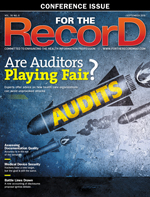September  2018
2018
By The Numbers
For The Record
Vol. 30 No. 8 P. 34
22
According to the 2018 HIMSS Compensation Survey, female HIT executives now make this percentage less than their male counterparts. Female clinical managers have been the hardest hit, making 59 cents on the dollar compared with men in the same position.
612,955
According to data from the Office for Civil Rights, there were this number of breached paper or film records reported in April, comprising 80% of the 757,344 breached paper or film records reported in the first half of 2018 and making April the biggest month for paper record breaches so far this year. Most of the records—582,174—were attributed to a break-in at the California Department of Developmental Services during which, according to department reports, trespassers ransacked files, vandalized and stole property, and started a fire.
84
The University of Michigan's National Poll on Healthy Aging found that adults aged 50–80 who have set up a patient portal commonly use it to see test results (this percentage), request a prescription refill (43%), schedule an appointment (37%), request reminders about upcoming appointments (34%), get advice about a health problem (26%), update insurance or contact information (22%), and get a referral (13%).
$110,000
The average salary for an HIT professional was about this amount, according to the 2018 HIMSS Compensation Survey. However, women and minorities made significantly less than their white male colleagues. On average, men made more than $123,000 annually, while women made just over $100,000. Nonwhite females experience "double-jeopardy," with an average salary that is nearly $26,000 less than that of a white male colleague.
1 in 5
This number of patients said they have changed physicians because of long wait times, and 30% of patients said they have walked out of a medical appointment due to long wait times, according to Vitals' annual Physician Wait Time Report. Those who said they have excellent access to top-quality physicians were less likely to leave, compared with those who said they have poor health care access (20% vs 53%).
79
This percentage of respondents to a Health Catalyst survey rated their organization's success in improving patient safety either "somewhat good" or "very good." Only 11% rated their patient safety efforts as "poor," but on the other hand only 9% gave their efforts an "excellent" grade.
30
According to a Health Catalyst survey, top barriers to improving patient safety include ineffective IT (data quality, patient matching, reporting) and the lack of real-time warnings for possible harm events, which requires technology (this percentage); lack of resources, including staffing and budget (27%); organization structure, culture, or priorities (19%); lack of reimbursement for safety initiatives (10%); and changes in patient population and practice setting (9%).



